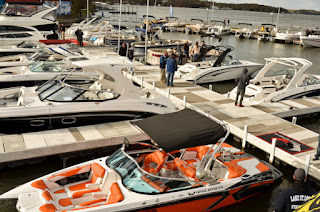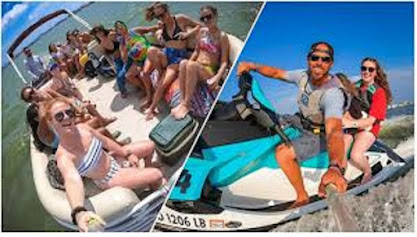In a Heart Beat - Tragedy
ROBERTS, Wis. published by KSDK-TV — A western Wisconsin woman hopes the wounds on her back are enough to get a message across to other boaters.
Tera Busker was injured by a boat propeller after falling off the bow of her pontoon.
“The takeaway is never ride on the front of a pontoon. As much as it looks like a lot of fun, it’s not worth it,” Tera says.
It was 4th of July. Tera and her 3-year-old niece were sitting on the pontoon’s bow, with Tera’s legs hanging over the edge.
Tera’s husband slowly steered the boat through a no wake zone.
“Somebody came into the no wake zone going way too fast and it actually created a pretty big wave,” Tera says. “It grabbed my feet and because I had my arm around her, it pulled both of us under the boat.”
Tera’s niece was tucked in front of her and made it through the tunnel between the boat’s two floats.
But Tera’s back came in contact with the boat’s propeller.
Family members and people on another boat quickly came to her aid.
Tera was airlifted to an Eau Claire hospital with a punctured lung, four broken vertebra and four ribs broken or shattered.
Doctors used 27 staples to close her back up.
A month after the accident, Tera is still undergoing physical therapy.
“Centimeters and I would have had a severed spine,” Tera says.
Boating accidents happen in a heart beat. As captain you are responsible any the damage of personal property; for the safety of your passengers. Also must ensure all the passengers on board are doing their part to have a safe outing.
Riding on the bow in front of guard rail, on the sunpad on the stern or on the gunnels, while underway, of the boat is illegal and extremely dangerous. In Missouri the individual(s) riding will not get the fine but the operator of the vessel. It may be a fun ride until a person falls off and is chopped by the prop or is ran over by the boat and drowns.
2018 USCG Boating Safety Statistics
Published on August 28th, 2019
Every year, the U.S. Coast Guard compiles statistics on reported recreational boating accidents. These statistics are derived from accident reports that are filed by the owners / operators of recreational vessels involved in accidents.
The fifty states, five U.S. territories and the District of Columbia submit accident report data to the Coast Guard for inclusion in the annual Boating Statistics publication. The recreational boating statistics for 2018 have now been released.
According to the report, there were 633 boating fatalities in the U.S. last year, a 3.8 percent decrease from 2017. The report also said that recreational boating injuries were down 4.5 percent (2,629 to 2,511) in 2018 compared to the previous year.
“While these decreases are encouraging, there are still too many deaths and injuries that could be avoided through the use of life jackets and eliminating alcohol consumption while operating a boat,” said Capt. Scott Johnson, chief of the Office of Auxiliary and Boating Safety at Coast Guard Headquarters.
he Coast Guard reported that alcohol continues to be the leading known contributing factor in fatal boating accidents in 2018, accounting for 100 deaths, or 19 percent of total fatalities.
“It is heartbreaking to realize that more than 100 people could still be alive today had alcohol use been curbed,” Johnson said. “Anyone who’s spent long periods of time out on the water knows that alcohol consumption, when combined with fatigue from sun and wind exposure, will severely hinder a person’s ability to make good decisions and maintain awareness of their surroundings.”
The report also shows:
• The fatality rate was 5.3 deaths per 100,000 registered recreational vessels, which tied as the third lowest rate in the program’s history. This rate represents a 3.6 percent decrease from last year’s fatality rate of 5.5 deaths per 100,000 registered recreational vessels.
• Property damage totaled about $46 million.
• Operator inattention, improper lookout, operator inexperience, machinery failure, and excessive speed ranked as the top five primary contributing factors in accidents.
• Where the cause of death was known, 77 percent of fatal boating accident victims drowned. Of those drowning victims with reported life-jacket usage, 84 percent were not wearing a life jacket.
• The most common vessel types involved in reported accidents were open motorboats, personal watercraft, and motorboats with interiors. Vessel types with the highest percentage of deaths were open motorboats (50 percent), kayaks (13.5 percent), and canoes (7 percent).
Jan. 1st through Oct. 1st of 2017:
1. Total number of boating
crashes. 75
2. Total number of injury
boating crashes. 32
3. Total number of
injuries. 45
4. Total number of injury
boating crashes involving one of more rental boat(s).
26
5. Total number of injuries
involving one of more rental boat(s). 38
6. Total number of
Drownings. 7
7. Total number of
BWI’s. 73
Jan. 1-Oct. 1, 2018 stats:
8. Total number of boating
crashes. 85
9. Total number of injury
boating crashes. 41
10. Total number of injuries
from. 62
11. Total number of injury
boating crashes involving one of more rental boats. 38
12. Total number of injuries
involving one of more rental boats. 59
13. Total number of
Drownings. 3
14. Total number of
BWI’s. 82
1. Total number of boating
crashes. 75
2. Total number of injury
boating crashes. 35
3. Total number of
injuries. 47
4. Total number of injury
boating crashes involving one of more rental boats. 38
5. Total number of injuries
involving one of more rental boats. 39
6. Total number of
Drownings. 4
7. Total number of BWI’s. - 54
Alcohol continued to be the leading known contributing factor in fatal boating accidents in 2018 and 2019, accounting for 100 deaths, or 19 percent of total fatalities.
“It is to realize that more than 100 people could still be alive today had alcohol use been curbed,” aid Capt. Scott Johnson, chief of the Office of Auxiliary and Boating Safety at Coast Guard Headquarters. “This was just one tragedy that could have been prevented by removing alcohol from the day’s activities,” Johnson said. “Anyone who’s spent long periods of time out on the water knows that alcohol consumption, when combined with fatigue from sun and wind exposure, will severely hinder a person’s ability to make good decisions and maintain awareness of their surroundings.”
Boating and alcohol to excess do not mix. Use a designated sober captain. Have fun boating, Remember one mistake, one careless act will ruin the day. Boat safe boat sober.





Comments
Post a Comment